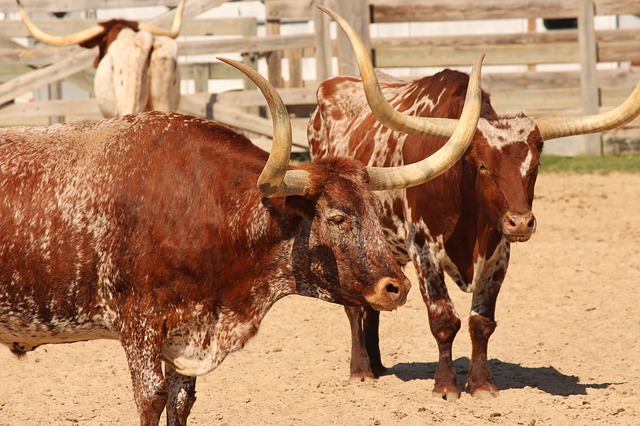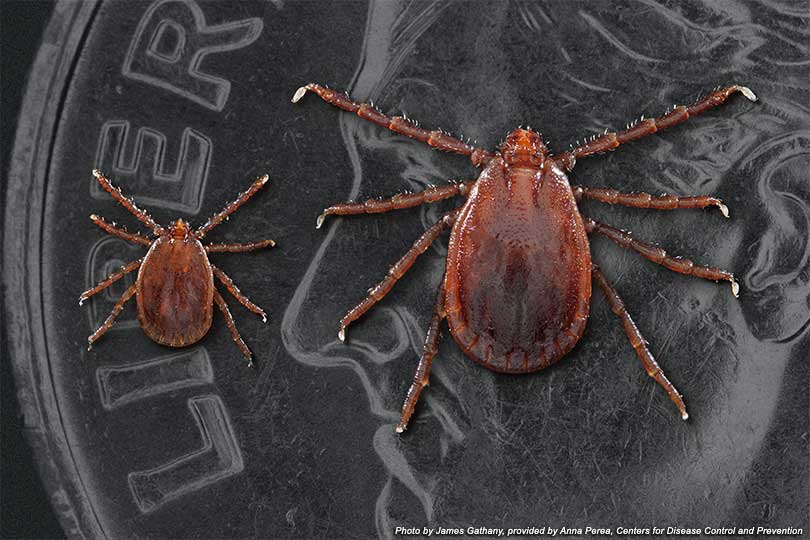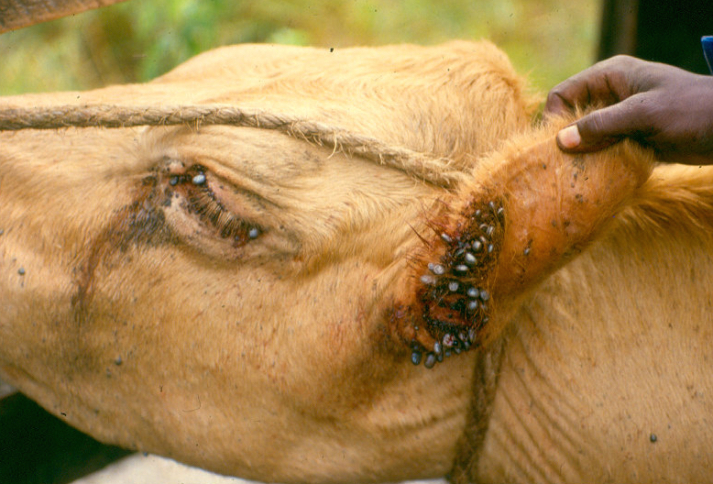In Texas when you hear “longhorn” there are really only two things that come to mind: football and cattle. But there’s a new “longhorn” making news lately in the U.S., the Asian longhorn tick. This pest is native to East and Central Asia, but seems to be finding new footholds, first in New Zealand, Australia, and other Pacific locations, and now in the United States. With the recent discovery of a sizable colony infecting a sheep in New Jersey, the Asian longhorn tick has gotten national attention as a possible new invasive species (the extent and probable ramifications are still being determined). Though these new longhorn pests haven’t yet been documented in Texas, they are worth a look not only because of the potential for them to spread here as they get a foothold in the U.S. but also because it’s a good reminder of tick safety, which is something everyone should be thinking of as summer begins to wind down and camping trips become ever more common while time and weather allow.
What do Asian longhorn ticks look like?
These invasive pests are small, ranging from less than 0.1” (or smaller than a poppy seed) up to the size of a pea when an adult is fully engorged with blood. They are inornate and nondescript to the naked eye, with a light-to-dark red-brown coloring and without any markings or distinct coloration. Their mouth parts are shorter and wider than many other common tick species, though this distinction is more likely to be seen by an expert than by the average person. Juveniles are unfortunately small enough that they often go unnoticed, leading them to regularly be found in very high numbers when they are discovered. Ticks of all stages can be found feeding on the ears, back of the neck, shoulders, groin, and armpits. Because these ticks are so generic and resemble other native tick species in the United States, they are difficult to distinguish, even for professionals.
Where are Asian longhorn ticks located?
Regionally, they are native to East and Central Asia and are an established invasive species in Oceania. In the United States there have been documented sightings in New Jersey, Virgina, West Virginia, Maryland, North Carolina, New York, Pennsylvania, and Arkansas; these sightings have been verified back to at least 2013. There is concern that they will spread further into the United States, especially since these ticks are capable of essentially hibernating so that they can survive in a wide range of climates.
The preferred habitats for Asian longhorn ticks, like many other tick species, are areas of tall grass with high humidity levels near the soil. Examples of these conducive areas are: pastures, hay fields, wildflower areas, and other unmowed tracts. They are especially common in areas where animals are likely to traverse; the ticks will hold onto a blade of grass with their rear legs and keep their front legs aloft, using them to grab onto a host that passes by.
Are Asian longhorn ticks common?
In the United States, they are a very new arrival, so the number of documented cases is still quite small. However, when an Asian longhorn tick colony is discovered, it’s often an extremely dense population. They are able to create such excessive numbers due to the fact that all documented females in the United States reproduce via parthenogenesis (the development of an egg without fertilization from a male), which shortens the overall length of the life cycle. Though these ticks will still need to feed off of three hosts in order to reach maturity, one in each of its life stages, in the span of a year, it can go from a newly lain egg to an adult capable of producing up to 2,000 eggs in less than a three week period. And since all of these ticks are capable of reproducing at this capacity, you can see how a population can quickly get out of control.
What is the difference between Asian longhorn ticks and deer ticks?
Most people would be hard-pressed to see a clear difference between the two ticks. Though deer ticks can have more distinguishing coloring than Asian longhorn ticks, they are very similar in size and the male ticks are often a plain brown, which can be similar to the longhorns.
The two biggest differences are that the Asian longhorn ticks in the United States reproduce exclusively via parthenogenesis, as opposed to deer ticks which mate via sexual reproduction, and that, as far as we know, they are carriers of different diseases; see the next section for more on this.
Are Asian longhorn ticks dangerous?
The short answer is yes, Asian longhorn ticks are dangerous. But the way in which they are dangerous and who they are dangerous to makes this a bit of a more complicated question. Where this tick is native, East Asia, it is known to carry several viruses and bacteria that can be harmful to humans and cause potentially severe illnesses, such as SFTS, human granulocytic anaplasmosis, and Japanese spotted fever. Fortunately, in the United States there haven’t yet been any reported cases of human bites by the Asian longhorn ticks, but this doesn’t mean that we are in the clear. Since they are still very new to the U.S., researchers haven’t yet determined what viruses and bacteria they can be host to on our shores, but there is concern they could carry a variety of pathogens that our native ticks carry and become another vector for their proliferation. Pathogens such as Lyme disease, Rocky Mountain spotted fever, Powassan disease, and other dangerous diseases which can have long-lasting effects from arthritis and inflammation of the brain to amputation and even death.
Though they are not yet a documented threat to humans in the U.S, they are, however, a known danger to livestock and animals. In the U.S. these ticks have been seen on cattle, sheep, goats, horses, deer, opossums, raccoons, and dogs. Not only are these pests carriers of the pathogens that cause babesiosis (an infection which attacks red blood cells and can cause anemia and systemic shock and which is prone to relapse) in dogs and theileriosis (an infection of red and white blood cells which can cause anemia, jaundice and even death) in cattle, but they can also infest an animal to such an extent, due to their large populations, that they can cause anemia and death by exsanguination.
Experts caution that though there is potential for concern with these new invaders, it’s important to remember that there is also an immediate concern from native ticks, whose regions and populations have been growing as winters have warmed. Lyme disease is a dangerous illness and it’s estimated that in parts of the United States 25% of deer ticks carry it, presenting a threat worthy of bearing in mind even as new species are drawing our attention.
How do you prevent tick bites?
Whether we’re discussing Asian longhorn ticks, deer ticks, or any other tick, it’s important to take steps to prevent yourself and your animals from being bitten, especially in late Spring and early summer when the ticks are looking for blood meals to continue through their life cycle. If you live in an area where you are concerned about a tick population in your yard, especially if there are wooded or grassy areas nearby, the best thing to do is call a pest control professional to have your yard treated with products specifically designed to eliminate ticks. In addition to professional treatment, maintain a a low grass height, keep your yard weed-free, reduce or remove brush areas, and eliminate any wood debris.
If you will be visiting a potential tick harborage area that has not been professionally treated, it’s best to heed the basic rules of tick prevention: wear long sleeves and pants, apply insect repellent that contains DEET (on people only; DEET can be harmful to pets), keep your pets up-to-date on preventative tick treatments, and completely check yourself and your pets for ticks as soon as you are able. For more on prevention and symptoms check out the CDC page on ticks.
This summer as we head into fall, be sure to practice good tick safety whenever adventuring outdoors. And keep an eye out for the new tick on everyone’s radar lest this longhorn begin to infest our beloved longhorns.
Additional Resources:
“Asian longhorn tick, (AKA, East Asian, Scrub or Bush Tick): Newly Discovered Invasive Tick in the United States” – The TickApp for Texas & the Southern Region
“This invasive tick can clone itself and suck livestock dry” – Leah Rosenbaum – ScienceNews
“5 Things to Know About the New Tick Species in the US” – Rachael Rettner – Live Science
“Tick Bites: Symptoms & Treatment” – Elizabeth Palermo – Live Science
“Asian Longhorned Tick, Haemaphysalis longicornis” – Michael J. Skvarla & Erika Machtinger – PennState Extension
“An Invasive New Tick Is Spreading in the U.S.” – Donald G. McNeil Jr. – The New York Times











